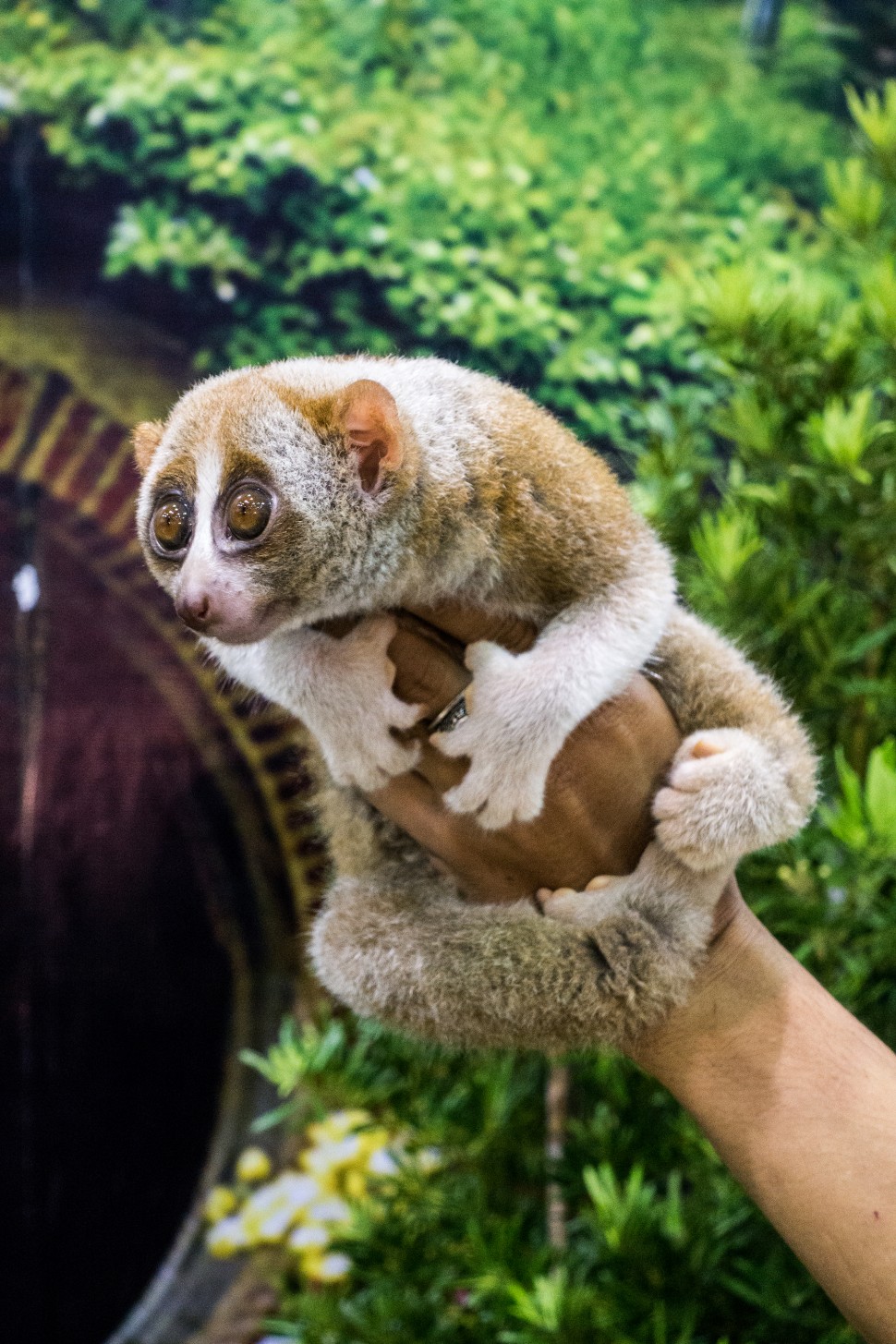As videos and selfies of these wide-eye creatures as pets become a trend, so does the danger of the primates becoming extinct

You’ve seen the YouTube videos where the slow loris raises its arms while being tickled. Or where it appears to be enjoying itself being brushed, all wide-eyed. How about slow loris selfies, where the animal is a photo prop for memorable travel photos you show friends back home? Now if you knew that the slow loris is actually being tortured in these “cute” scenarios, would you still like the video or say yes to having your photo taken with one?

Sadly, many of us are unaware of the harm the slow loris goes through purely for our entertainment. It is this ignorance that fuels street vendors to use the animal as a means of making money through tourist traps and illegal traders to capture, smuggle and sell slow lorises as pets, taking the animal away from its natural habitat and into one that causes it harm, pushing it slowly to extinction.
“For a long time, slow lorises were targeted largely for meat and traditional medicine but over time we have increasingly seen them in the pet trade. We have found dozens for sale in markets and used as photo props in some Southeast Asian countries,” says Claire Beastall, Training and Capacity Building Coordinator at TRAFFIC, an international organisation dedicated to delivering innovative and practical solutions to wildlife trade issues by working closely with governments and the private sector.

Because it is perceived as “oh so cute!” – no thanks to the viral videos – the demand for slow lorises as a pet is on the rise. In fact, a great deal of the trade happens online with very young slow lorises sold as pets on social media and messaging apps. In Malaysia itself, a TRAFFIC survey found that slow lorises were among the most frequently encountered animal for sale online.
How is all this causing harm to the animal? First and foremost, the endangered animal is often captured from the wild using snares that can maim or kill them. Young ones are ripped away from their mothers, drugged and then shoved into plastic crates and bags, taken away from their home.
Their circumstances don’t improve from there. Before being sold, their sharp teeth are clipped out using pliers with no anesthesia to prevent the animal from biting their handler, a bite that can kill. Do a search on the Internet for videos on this process and you’ll be horrified for the pain the poor animal goes through. Then, the animal is smuggled in inhumane conditions before making its way into a tiny cage, fed inappropriate food instead of the diet it thrives on in the wild, and shoved into bright light despite being a nocturnal animal. In a 2016 study, researchers from Oxford Brookes University examined a hundred online videos of pet lorises, and their conclusion? All these animals were distressed, sick or exposed to conditions unnatural to them.
All eight species of slow lorises are considered threatened, and the Javan slow loris is one of the 25 most endangered primates worldwide. The slow loris is protected by local laws in Southern Asia and by the Convention on International Trade in Endangered Species (CITES), a treaty that aims to prevent trade that could threaten wild species’ survival. How did they end up in our homes and used as props at popular holiday destinations then? “Unfortunately, where demand exists, someone will often see a chance for profit. These criminals give no thought to the continued survival of these animals in the wild or the well-being of the individuals caught up in this illegal trade,” says Beastall. By paying to have your photo taken with a slow loris, not only are you encouraging wildlife poaching and the ill treatment of these animals, you are supporting an illegal business.

As for slow lorises that are being trafficked as pets, they are often trafficked via airlines in baggage or hidden under clothing. Authorities all over the world regularly seize wild animals from check-in and hand-carry baggage, cargo and even the post. “Wild animals do not make good pets, whatever the species,” says Beastall. “Some species become trendy after they have been featured in celebrity pictures, movies or even viral videos. The effects of even such fleeting popularity can be devastating to wild animal populations long after everyone has moved on to focus on the next big thing.” In the case of the slow loris, the animal appeared in Rihanna’s Instagram post, while YouTube videos get millions of likes and comments starting with “where can I get one?”
In a 2016 study, researchers from Oxford Brookes University examined a hundred online videos of pet lorises, and their conclusion? All these animals were distressed, sick or exposed to conditions unnatural to them.
Where air trafficking is concerned, airlines come into play by educating their staff, contractors and suppliers to help detect wild animals being smuggled on their planes. In June 2017, Malaysia Airlines declared a Zero-Tolerance Policy on wildlife trafficking and has signed the Buckingham Declaration, a pledge taken by numerous leaders of the global transportation industry at Buckingham Palace to shut down illegal trafficking routes around the world. The airline will strictly adhere to CITES by not allowing any animal, flora and fauna classified as endangered to be transported in any of its aircraft.
The airline’s ground staff, such as its security personnel and MABKargo’s ground staff, have been trained in anti-wildlife trafficking courses, while its cabin crew will undergo a similar training soon to raise awareness on the illegal wildlife trafficking trade, laws and regulations, things to look out for and what to do if they suspect anything. Training material for these sessions are provided by TRAFFIC, and the two organisations have also collaborated in awareness-raising events for the public.

“Malaysia has extremely good transport links, making it attractive not just for travellers but also for wildlife smugglers. Information on illegal wildlife trade is on display at many of Malaysia’s airports, and frequent checks on passengers, luggage and cargo have resulted in numerous wildlife seizures. The authorities are working hard to make sure that there is no room for wildlife traffickers in Malaysia,” says Beastall.
Just as we play a part in pushing the slow loris to extinction, we can also be the solution in ending its illegal trade. “Do not support activities or attractions that involve illegally traded wildlife. If you see something, report it. Stopping the illegal wildlife trade and protecting the world’s wildlife is not just the responsibility of the enforcement agencies – we can all play a role,” says Beastall.





